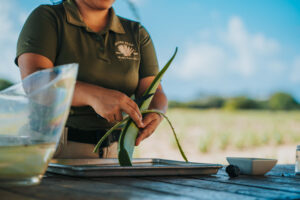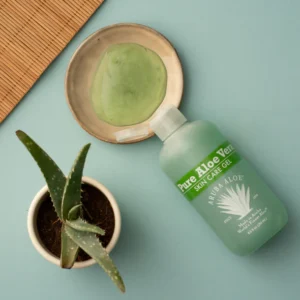Aruba is renowned for its pristine white sandy beaches, but a lesser-known treasure is its thriving Aloe Vera industry. Introduced in the mid-1800s, Aloe Vera has become integral to the island’s heritage and economy. Celebrated for its healing properties, this versatile plant is used in various products, from skincare to health supplements. Visitors to Aruba often explore the Aruba Aloe Factory, where they can learn about the plant’s history, cultivation, and production processes. Here are the top five facts about Aloe Vera in Aruba that every visitor should know.
1. A Rich History Rooted in the 1800s
Aloe Vera was first introduced to Aruba in 1840, quickly becoming an integral part of the island’s culture and economy. In fact, at one point, Aruba exported so much Aloe Vera that it was nicknamed the “Island of Aloe.” Today, this legacy lives on, and visitors can learn more about its history at the Aruba Aloe Factory and Museum.
In Aruba, locals often rely on fresh Aloe Vera
2. The Healing Powers of Aloe Vera
Known as the “Plant of Immortality,” Aloe Vera has been used for centuries to heal sunburns, cuts, and skin irritations. In Aruba, locals often rely on fresh Aloe Vera gel for its soothing properties—a natural remedy that’s deeply ingrained in the island’s culture.

3. Perfect Growing Conditions
Aruba’s dry climate and sandy soil make it the ideal location for cultivating Aloe Vera. The intense sunlight ensures that the plants thrive, resulting in high-quality Aloe Vera with potent nutrients.
4. The Aruba Aloe Factory Experience
A visit to the Aruba Aloe Factory is a must for anyone interested in this remarkable plant. Here, you can see how Aloe Vera is cultivated, harvested, and processed into products like lotions, shampoos, and skincare treatments. The factory also offers tours that delve into the plant’s historical significance.
5. Unique Products You Can Take Home
Aruba Aloe products are some of the finest in the world, made from locally grown Aloe Vera and carefully crafted to preserve its healing properties. Visitors can shop for these high-quality items at the factory or local stores, bringing a piece of Aruba’s natural heritage back home.

Experience Aruba’s Aloe Heritage on a Private or Island Tour
Want to see Aruba’s rich Aloe Vera legacy up close? There’s no better way to experience it than with a guided tour. At Aruba Fantasy Tours, we offer half-day and full-day island tours or fully customizable private tours that give you an insider’s view of Aruba’s Aloe Vera industry.
Visit the famous Aruba Aloe Factory to learn how this incredible plant is cultivated and transformed into high-quality products. Our knowledgeable guides will share fascinating insights about Aloe Vera’s history on the island and its importance to Aruba’s culture and economy.
Whether you’re traveling with family, friends, or just looking for a personal experience, our tours are designed to make your trip unforgettable. Discover the stories, traditions, and natural beauty that make Aruba so special—all at your own pace.
Ready to explore Aruba’s Aloe Vera story? Book your tour now and let Aruba Fantasy Tours take you on a journey of discovery and relaxation.
